Translate this page into:
Frequency of comorbid diseases with high serum Vitamin B12 levels in patients attending King Salman Medical City (KSAMC), at Madinah
Address for correspondence: Gihan M. Adham, Department of Laboratory, Madinah General Hospital, King Salman bin Abdul Aziz Medical City, Madinah Munnawarah, Saudi Arabia. Phone: +00966504645283. E-mail: gadham@moh.gov.sa
This is an open-access article distributed under the terms of the Creative Commons Attribution-Noncommercial-Share Alike 3.0 Unported, which permits unrestricted use, distribution, and reproduction in any medium, provided the original work is properly cited.
This article was originally published by Qassim Uninversity and was migrated to Scientific Scholar after the change of Publisher.
Abstract
ABSTRACT
Objectives:
Vitamin B12 (Cobalamin or Cbl) plays a crucial role in normal human growth and development, as well as in neurological, cardiovascular, and immune systems. Previous studies reported association of high levels of cobalamin with solid cancers, hematological disorders, and liver diseases. Reporting the frequency of comorbid diseases with high serum Vitamin B12 level in patients attending KSAMC at Madinah.
Methods:
This is a retrospective, cross-sectional study on data collected during 1 year (May 2022–May 2023) from 3511 report, patients with high cobalamin blood level (normal upper limit 771 pg/mL) as determined in our laboratory on COBAS® were included. Patient’s clinical diagnosis, medication history and other laboratory parameters performed were also checked for disease comorbidities.
Results:
Our results revealed statistically significant increase in serum Vitamin B12 in patients with diabetes mellitus, with the use of this vitamin as supplement therapy 53.2% (the predominant comorbidity), together with liver, blood, chest, kidney, thyroid and neurological diseases, and various solid tumors. A positive correlation was found between serum Vitamin B12, age and laboratory parameters including aspartate aminotransferase, gamma-glutamyl transferase, and direct bilirubin, and a negative correlation was seen between serum Vitamin B12 level, serum albumin (ALB), red blood cell count, hemoglobin, and free T3 (FT3). While, no significant correlation with the rest of the checked parameters was detected.
Conclusion:
This study found high serum level of Vitamin B12 associated with various disease entities, for example, (diabetes mellitus treated with Vitamin B12 as supplement therapy, liver, blood, chest, kidney, thyroid, neurological diseases, and various solid tumors), so when Vitamin B12 is high, further investigations will be recommended. Most of the comorbidities were benign in Saudis, followed by Egyptians with predominance of female-aged 50–70 year old.
Keywords
Diabetes mellitus
hematological disorders
hyperthyroidism
liver diseases
solid tumors
Vitamin B12 (cobalamin)
Introduction
Vitamin B12 is a water-soluble vitamin, present as a constituent of animal products such as meat, liver, kidneys, eggs, shellfish, and dairy products. This vitamin has a significant role in DNA synthesis and hence in human growth and development, formation of red blood cell (RBCs), and specially myelin sheaths around the nerves, being an essential factor for neurological functions, and in maintaining homocysteine levels within a healthy range.[1] Adequate Vitamin B12 also helps to maintain inflammatory cytokines, reduces the risk of cardiovascular diseases,[2] and boosts the immune system.[3]
Vitamin B12 deficiency can cause anemia, poor memory, depression and various ailments associated with nerve damage such as numbness and paresthesia in hands and feet. The prevalence of Vitamin B12 deficiency leads the physicians to prescribe it to their patients empirically, resulting in its high level in blood.[4]
Low cobalamin level does not always indicate its deficiency; however, an abnormally high level may indicate the need to exclude certain serious underlying pathologies.[5]
Previous studies suggest that high cobalamin levels are found in patients with solid cancers,[6] hematological disorders, liver disorders, renal failure, monoclonal gammopathy of undetermined significance, and not uncommonly due to excess intake of Vitamin B12.[7,8]
High levels of Vitamin B12 in autoimmune disease could be due to production from leukocytes, decreased uptake and decreased filtration by trans-cobalamin autoantibodies. In autoimmune lymphoproliferative syndrome, it may increase 15 times of normal.[9]
Blood tests are the only way to verify high Vitamin B12 level, as excessive amounts alone does not cause any symptoms or signs.[10]
Recently, a study among the Saudi diabetic population found that patients on metformin were prescribed Vitamin B12 supplementation as a routine practice without monitoring.[8] It is therefore, important to study the frequency of hypervitaminosis of B12 in these disorders and its relation to its supplement intake, also reporting the frequency of comorbid diseases associated with high serum Vitamin B12 levels. There is no similar studies in different cities and regions in Saudi Arabia have been conducted with similar objectives.
Patients and Methods
This is a retrospective, cross-sectional study (from May 2022 to May 2023). During the selected period, serum Cobalamin level was measured in 3511 patients attending KSAMC at Madinah. Hypervitaminosis was recorded in 248 test result (7.1%), where 213 (6%) test result were below the normal lower limit.
By reviewing all patients’ medical records, using Medicacloud (Hospital Information Management system), including clinical data: age, gender, comorbidity, and history of Vitamin B12 supplement and laboratory investigations including CBC, peripheral smear, liver and kidney function tests, thyroid function tests and/or others were recorded.
The inclusion criteria included; adult patients of both sexes (males or females) with one or more diagnosis and patients with elevated levels of serum Vitamin B12. As determined in our laboratory using COBAS-e 601 chemiluminescence autoanalyzer, using Roche reagents (Roche Diagnostics Gmbh, D-68289 Mannheim, Germany), normal upper limit 771 pg/mL.
Exclusion criteria included incomplete medical records.
Statistical analysis
The data were analyzed using the statistical package for social sciences, version 23.0 (SPSS Inc., Chicago, Illinois, USA). Quantitative data were presented as mean, ± standard deviation and ranges. Qualitative variables were presented as numbers and percentages. The tests included were spearman’s rank correlation coefficient (sr): To assess the degree of association between two sets of variables if one or both of them was skewed; positive denotes an increase in the independent variable is directly proportional to the increase in the dependent variable while negative denotes an increase in the independent variable is indirectly proportional to decrease in the dependent variable; scatter plot was plotted on values of two variables along two axes, the pattern of the resulting points revealed the presence of correlation; the confidence interval was set to 95% and the margin of error accepted was set to 5%. The probability (P-value) was considered significant if <0.05, highly significant if <0.001 and insignificant if it was >0.05.
Results
The results of the present study are demonstrated in the following [Tables 1-5 and Figures 1-6]: The predominant sex were females and age from 50 to 70 [Table 1]. The predominant nationality was Saudi and Egyptian [Figure 1]. Our results revealed statistically significant increase in serum Vitamin B12 in patients with diabetes mellitus, with the use of this vitamin as supplement therapy 53.2% (the predominant comorbidity), together with liver, blood, chest, kidney, thyroid, neurological diseases, and various solid tumors [Table 2]. Fatty liver was the predominant liver disease [Figure 2], while iron deficiency was the predominant blood disorder [Figure 3], thyroid disorder (hyper and hypothyroidism) are nearly equivalent [Table 3]. Bronchial asthma was present in 5.8% [Figure 4], cancer prostate representing 5% of the total number of tumors [Figure 5]. A positive correlation was found between serum Vitamin B12, age, laboratory parameters including aspartate aminotransferase (AST), gamma-glutamyl transferase (GGT), and direct bilirubin, and a negative correlation was seen between serum Vitamin B12 level, serum albumin (ALB), RBC count, hemoglobin, and free T3 (FT3) [Table 5 and Figure 6].

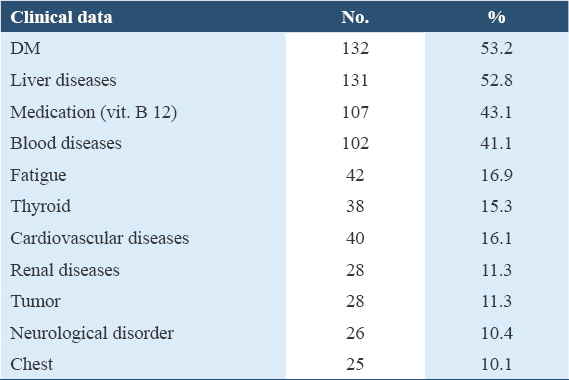
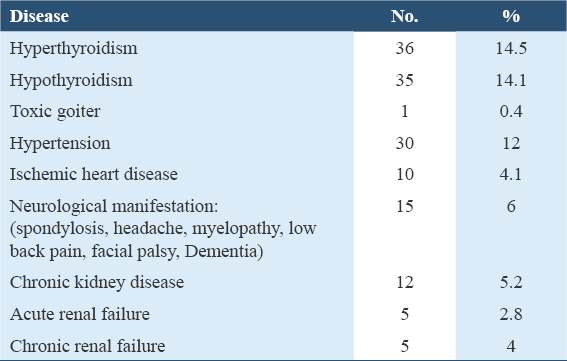
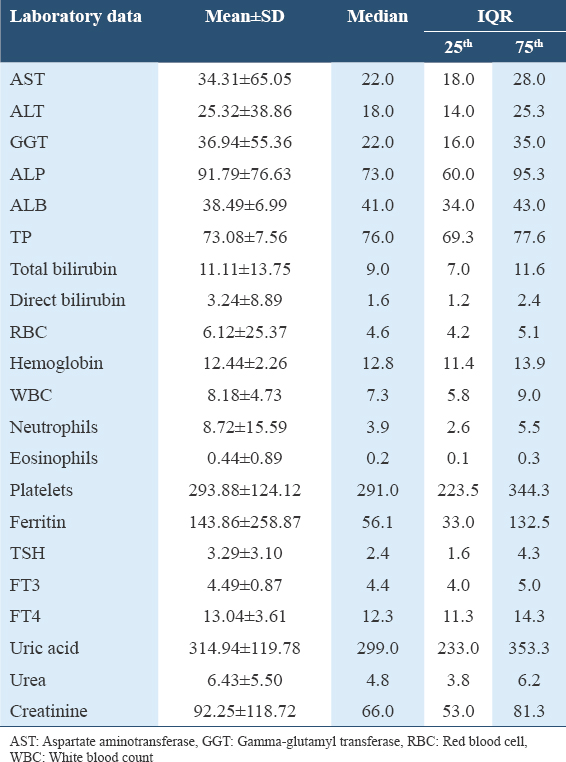
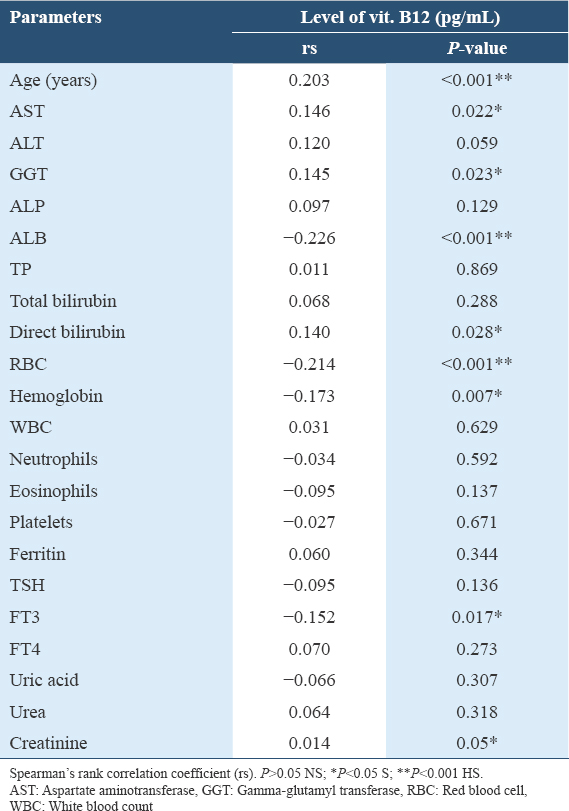
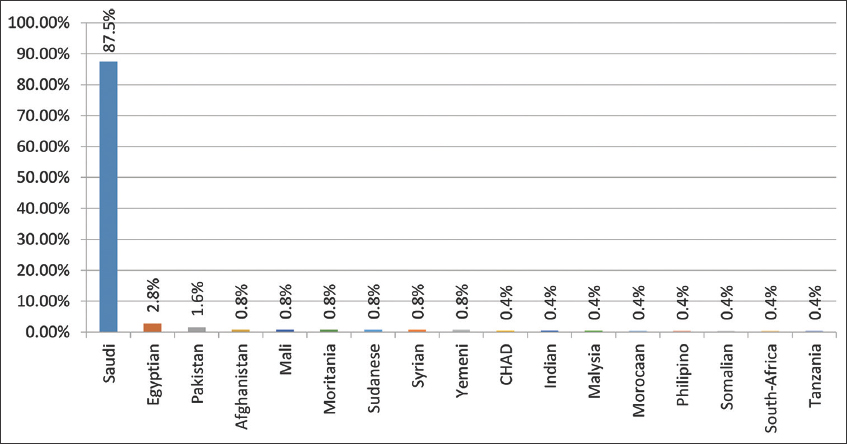
- Nationality distribution among study group
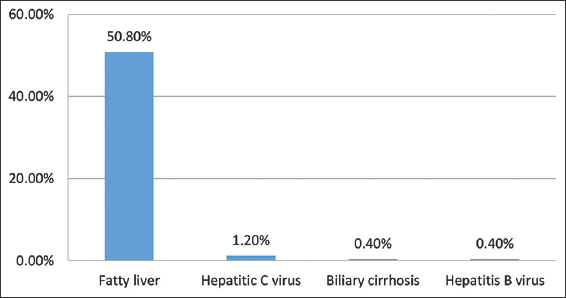
- Liver disease distribution among study group

- Blood disease distribution among study group

- Chest disease distribution among study group
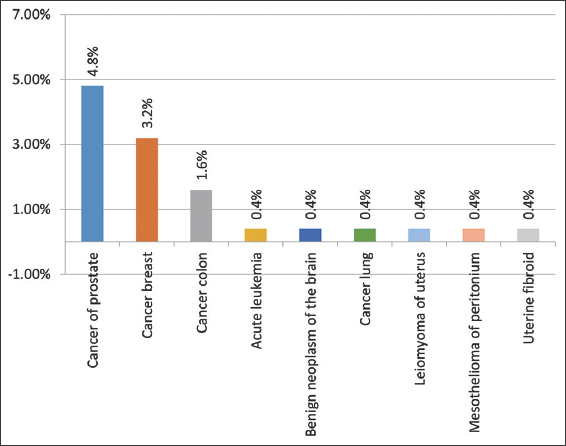
- Tumor distribution among study group
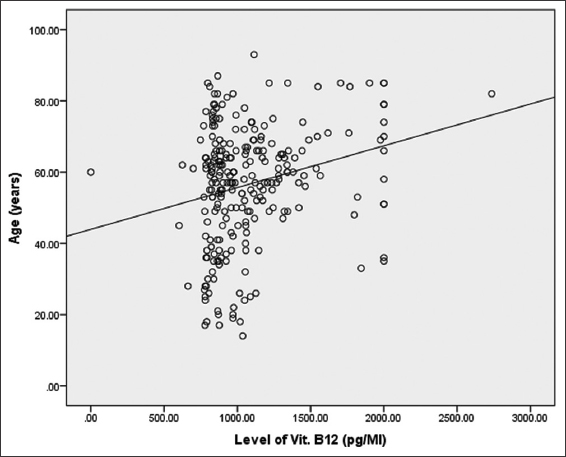
- Scatter plot between levels of vit. B12 with age “years”
There was a statistically significant positive correlation between Levels of vit. B12 (pg/mL) with Age (years), AST, GGT and D. BIL, with (P < 0.05); While, there was a statistically significant negative correlation between Level of vit. B12 (pg/mL) with ALB, RBC, HB and FT3, with (P < 0.05). While, the rest parameters have insignificant correlation, with (P > 0.05).
Discussion
Vitamin B12 is soluble in water, absorbed in terminal ileum, transported by haptocorrins and stored in the liver. It has a complexed chemical structure among other vitamins and its only source is from animal-based food or from supplement therapy.[11,12]
The commonest cause of its deficiency in developed countries is its impaired absorption. This may be due to the loss of the gastric intrinsic factor (IF), responsible for Vitamin B12 absorption.[13] During old age, achlorhydria is the second common cause.[14]
People taking long-term antacid therapy such as anti-H2 receptor medication or proton-pump inhibitors or any other antacids are at a greater risk of Vitamin B12 deficiency. Some anti-diabetic therapies, colchicine, extended-release potassium products, and certain antibiotics can also contribute to its deficiency.[15-17] Similarly, anti-seizure drugs such as phenobarbital, pregabalin, primidone can also cause lack of Vitamin B12.[18]
Disorders of cobalamin tissue uptake may cause raised serum cobalamin, paradoxically associated with signs of its functional deficiency causing noticeable clinical symptoms.[5]
High level of cobalamin may be a sign of some serious pre-existing disease such as solid neoplasia or hematological disorders. Other causes may include liver diseases, renal failure, and monoclonal gammopathy of undetermined significance. Less often hypervitaminosis occurs due to Vitamin B12 intake, inflammatory or underlying infectious disease,[19] alcoholism, autoimmune disorders, transient hematological disorders associated with neutrophilia or secondary eosinophilia.[1,20,21]
In our study, serum Vitamin B12 of 3511 patients revealed, abnormal 461 (13.1%) including 213 (6%) low result and 248 (7.1%) high result, data of these patients with hypervitaminosis were collected and analyzed.
This study was conducted in the laboratory of KSAMC, Madinah. It is a tertiary care hospital with a patient population of variable nationality, predominantly Saudi (87.5%) in which diabetes mellitus is common. Worldwide, the prevalence of chronic, noncommunicable diseases is increasing at an alarming rate. Diabetes is a major public health problem that is approaching epidemic proportions globally.[22]
As reported by the WHO, Saudi Arabia stands second highest in the Middle East, and seventh in the world with Diabetes as a prevalent disease. Approximately 7 million of the Saudi population are diabetic with almost half having pre-diabetes.[23] In the present study, diabetes was present in 53.2% of the study population.
There is high incidence of cobalamin deficiency in patients with diabetes mellitus, resulting in frequent prescription of this vitamin as an empiric therapy. This may reveal a paradoxically high blood level of cobalamin in diabetic population.
Chiche et al. in 2008,[4] reported that Vitamin B12 supplementation, represent <5% of all hypervitaminosis, compared with our study the incidence of diabetic patients who used Vitamin B12 as a supplement was 43.1%.
In our study, liver diseases represent 52.8% of our patients, which include (fatty liver, hepatitis C and B, and biliary cirrhosis); the high incidence of fatty liver may be due to high incidence of diabetes mellitus and obesity among the study group, but no liver cirrhosis or hepatic tumors were recorded. While Zulfiqar et al. in 2019[19] found cirrhosis of the liver, hepatocellular carcinoma and metastatic liver disease among their study group, showing high Vitamin B12 levels. This was explained by its release during hepatic cytolysis, and/or reduction in its clearance by the diseased liver,[24] although Vitamin B12 assay is usually not indicated in liver disorders, however, when Vitamin B12 is high, further investigations will be recommended.[24]
In our study, 41.1% of the patients had benign hematological disorders including (iron deficiency anemia, anemia of chronic disorder, leukocytosis, leucopenia, sickle cell anemia and acquired hemolytic anemia) and malignant hematological disorders including (acute lymphoblastic leukemia, chronic myeloid leukemia, multiple myeloma and polycythemia vera). This is in agreement with the analysis of Ciche et al. 2008,[4] Zulfiqar et al. 2019,[19] and Ermens et al. 2022,[23] who stated that hematological malignancy, transient hematologic abnormalities (neutrophilic hyperleukocytosis, hyper-eosinophilia) are associated with elevated levels of cobalamin.
Circulating cobalamin level increases in Hematological disorders mainly due to enhanced production of haptocorrin,[24] which is secreted from leukocyte granules in lymphoproliferative diseases, such as (autoimmune lymphoproliferative disease and myeloma) and myeloproliferative diseases such as (polycythemia vera and other cancers).[9]
Thyroid disease was present in 29% of the study group with elevated cobalamin including an almost equal number of cases of hyperthyroidism and hypothyroidism (14.6% vs 14.1% respectively) and toxic goiter constituting 0.4% of the studied cases.
We found fatigue in 16.9%, which is in agreement with Andres et al. 2013[5] who mentioned that in early stages of illnesses associated with high Vitamin B12, patients usually have this generic symptom associated with loss of appetite.
Renal diseases were present in 15.1% including renal stones, acute and chronic renal failure and cystitis. As regard renal failure, our results are in agreement with Carmel et al. 2001,[14] who found that renal failure associated with high cobalamin levels, is justified by the reduction in cobalamin clearance.
Tumors were present in 11.3% in the form of prostatic, breast, lung, colon cancer and acute leukemia, as well as benign neoplasm of the brain, uterine fibroid and mesothelioma of peritoneum. However, the finding of these small number of cases without metastasis is in agreement with the studies that documented elevated levels of cobalamin with tumors.[5,19,24] Ermens et al. 2022[23] mentions that serum cobalamin level can be used as a predictive parameter for the survival time in metastatic cancer patients.
Cardiovascular diseases were reported in this study in the form of hypertension (HTN) in 12%, and ischemic heart diseases (IHD) in 4.1% cases. This may be due to the high association between diabetes, HTN, and IHD. This is in agreement with Liu et al. 2017[24] who documented elevated levels of cobalamin with cardiovascular diseases.
We record neurological diseases in 6.4% of the study group in the form of spondylosis, neuropathy, headache, myelopathy, low back pain, facial palsy, and dementia. All these patients were receiving Vitamin B 12 as a supplement. Evidence suggests that taking Vitamin B12 as supplement therapy may reduce the cognitive decline by reducing the homocysteine levels, though a meta-analysis by Zhang et al. 2017 reported conflicting results on cognitive improvement induced by lowering the homocysteine levels when patients were placed on Vitamin B group.[25]
Chest diseases were present in (10.1%) in the form of asthma, pneumonia, acute bronchiolitis, pulmonary fibrosis, respiratory failure, and tuberculosis. Arendt et al. 2017, documented elevated levels of cobalamin with bronchopulmonary diseases.[21] The predominant age in this study was 50–70 years. Significant positive correlation was seen between Vitamin B12 (pg/mL) level with Age. This is expected as more comorbidities are seen in older patients. Also, AST, GGT and direct bilirubin, creatinine had a significant positive correlation with high Vitamin B12 in serum. Significant negative correlation was found between serum Vitamin B12 (pg/mL) with ALB, RBC, Hb% and FT3. The rest of the parameters showed insignificant correlation. With regards to ALB and creatinine, our results agree with Carmel et al. 2001.[14] In a study, Davut and Canan,[26] found that there was no correlation between Vitamin B12 with WBCs, neutrophil, lymphocyte, platelet, hemoglobin and ferritin levels. This study has few limitations: The feeding habits were not studied in the history; Holo-transcobalamin, and folic acid had not been performed; Relatively small number of the studied cases; Defining high Cobalamin levels as above the upper reference limit with no accurate cut-offs, with varying reference intervals with different measurement methodologies and the relevant populations. It is also important for us to show the study recommendations, which were clinical and lab follow up of adult patients with high cobalamin levels, whether they are medicated with or without Vitamin B12, for 2 years, at least 6 months for the development of hematological, liver and kidney diseases; a Follow-up or monitoring algorithm can be drawn for adult patients with high serum Cobalamin including testing for CBC with peripheral smear, ferritin, folic acid, holo-transcobalamin, liver and kidney function tests, tumor markers if necessary, and abdominal ultrasound. In case of cytopenia, the test panel should be expanded appropriately in consultation with Hematology; Further studies on a larger population keeping in view regarding their feeding habits is recommended. Metabolic pathway beginning from its oral intake to its final clearance and full genome analysis should be considered in future research, comparative studies are suggested using sCD320 and the receptor ligand and holo-transcobalamin.
Conclusion
The etiology of high serum cobalamin is associated with variable disease entities, and this study indicates these disorders are usually benign in nature; whether or not, high cobalamin level can be used as a biomarker for specific diseases remain inconclusive; it is not clear if the elevated B12 levels are resulted from supplementation or as a sequence of the disease; we suggest that patients with elevated levels of Vitamin B12 should be followed up for severe hematological, liver or kidney disease.
Ethical approval and Consent to Participates
Approval to participate were obtained from the Hospital Research Committee (IRB078-22) and has therefore been performed in accordance with the ethical standards laid down in the 1964 Declaration of Helsinki, informed consent is not applicable.
Consent for Publication
Availability of data and material
The authors confirm that the data supporting the findings of this study are available within the article.
Competing Interests
Authors have declared that no competing interests exist.
Funding Statement
There is no funding source.
Authors’ Contributions
All authors contributed to the study’s conception and design.
Acknowledgment
Not applicable.
References
- Association of Vitamin B12 with pro-inflammatory cytokines and biochemical markers related to cardiometabolic risk in saudi subjects. Nutrients. 2016;8:460.
- [Google Scholar]
- Vitamin B12, folic acid, and the immune system. In: Chapter in Nutrition and Immunity. Cham: Springer; 2019. p. :103-14.
- [Google Scholar]
- Clinical implications of high cobalamin blood levels for internal medicine. Rev Med Interne. 2008;29:187-94.
- [Google Scholar]
- The pathophysiology of elevated Vitamin B12 in clinical practice. QJM. 2013;106:505-15.
- [Google Scholar]
- Strength of the association of elevated Vitamin B12 and solid cancers:An adjusted case-control study. J Clin Med. 2020;9:474.
- [Google Scholar]
- Markedly increased Vitamin B12 concentrations attributable to IgG-IgM-vitamin B12 immune complexes. Clin Chem. 2006;52:2107-14.
- [Google Scholar]
- Analyzing relationship between Monoclonal Gammopathy of Undetermined Significance (MGUS) with different types of neuropathy:An observational study. Indian J Hematol Blood Transfus. 2016;32:186-92.
- [Google Scholar]
- Elevated Vitamin B12 levels in autoimmune lymphoproliferative syndrome attributable to elevated haptocorrin in lymphocytes. Clin Biochem. 2012;45:490-2.
- [Google Scholar]
- Diabetes mellitus in Saudi Arabia:A review of the recent literature. Curr Diabetes Rev. 2016;12:359-68.
- [Google Scholar]
- Growth, body composition, and cardiovascular and nutritional risk of 5- to 10-y-old children consuming vegetarian, vegan, or omnivore diets. Am J Clin Nutr. 2021;113:1565-77.
- [Google Scholar]
- The prevalence of cobalamin deficiency among vegetarians assessed by serum vitamin B12:A review of literature. Eur J Clin Nutr. 2016;70:866.
- [Google Scholar]
- Vitamin B12. In: Marriott BP, Birt DF, Stallings VA, Yates AA, eds. Present Knowledge in Nutrition. (11th ed). Washington, DC: Elsevier; 2020. p. :257-72.
- [Google Scholar]
- High serum cobalamin levels in the clinical setting-clinical associations and holo-transcobalamin changes. Clin Lab Haematol. 2001;23:365-71.
- [Google Scholar]
- The effects of proton pump inhibitors in acid hypersecretion-induced Vitamin B12 deficiency:A systematic review (2022) Cureus. 2022;14:e31672.
- [Google Scholar]
- Long-term metformin therapy and Vitamin B12 deficiency:An association to bear in mind. World J Diabetes. 2021;12:916-31.
- [Google Scholar]
- Revisiting Vitamin B12 deficiency:A clinician's guide for the 21st century. Pract Gastroenterol. 2018;182:28-49.
- [Google Scholar]
- Antiepileptic drugs interact with folate and Vitamin B12 serum levels. Ann Neurol. 2011;69:352-9.
- [Google Scholar]
- Hypervitaminosis B12. Our experience and a review. Medicina (B Aires). 2019;79:391-6.
- [Google Scholar]
- Persistent elevation of plasma vitamin B12 is strongly associated with solid cancer. Sci Rep. 2021;11:13361.
- [Google Scholar]
- Cobalamin related parameters and disease patterns in patients with increased serum cobalamin levels. PLoS One. 2012;7:e45979.
- [Google Scholar]
- Is diabetes becoming the biggest epidemic of the twenty-first century? Int J Health Sci (Qassim). 2007;1:V-VIII.
- [Google Scholar]
- The significance of an elevated cobalamin concentration in the blood. Ned Tijdschr Geneeskd. 2002;146:459-64.
- [Google Scholar]
- Associations of serum folate and Vitamin B12 levels with cardiovascular disease mortality among patients with type 2 diabetes. JAMA Netw Open. 2022;5:e2146124.
- [Google Scholar]
- Efficacy of Vitamin B supplementation on cognition in elderly patients with cognitive-related diseases. J Geriatr Psychiatry Neurol. 2017;30:50-9.
- [Google Scholar]
- Clinical follow-up of children with high vitamin B12 values:should we worry? The Turkish Journal of Pediatrics. 2021;63:1064-1071.
- [Google Scholar]







